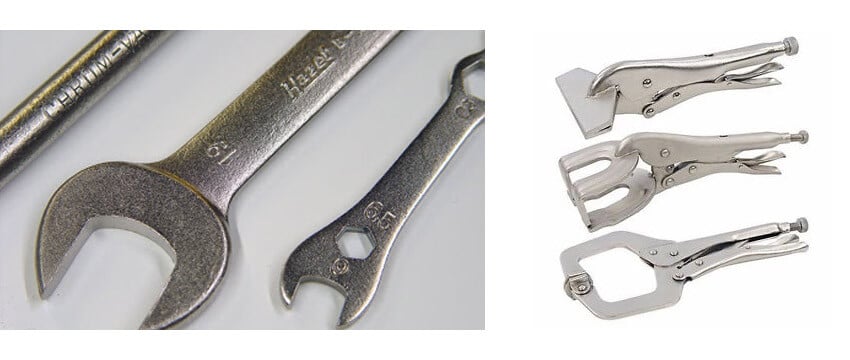- 0086-539-8039803
- rex@rexfactory.com
Nickel Plating
Nickel plating is a versatile surface finishing process used for decorative, engineering manufacturing purposes and electro-forming, a process of producing an all-nickel articles.
The purpose of using nickel plating for decorative is to achieve bright, smooth and mirror-like metal parts that will be used for consumer goods. Engineering requires nickel plating to give the substrate corrosion resistance.

The application of nickel plating for electroforming is to transform parts to pure nickel for commercial products like dies, molds, record stampers, textile printing screens and seamless belts.
Before proceeding with nickel plating, you must take cognizance of factors like getting the right nickel thickness and making sure that you achieve a uniform thickness on every significant surface.
Nickel Plating Process
The process of nickel plating as a surface finishing process is very popular in the industry because there are so many things you can achieve on the surface of the substrate by using nickel.
Nickel plating can be used to enhance the appearance of an otherwise dull and unattractive metal part to an attractive and part of the manufacturing of appealing end-user products. It can also work in the engineering processes for
manufacturing as well as electro-forming applications.
When it comes to achieving decorative coatings on a metal part, you can electroplate nickel through specialized solutions that contain nickel and other organic agents. The results of such processes are a coating that will be smooth, protective and mirrors bright on the surface of the substrate.
If it is for engineering applications, you need to prepare a solution that will only deposit nickel and nothing else.
The main reason for applying nickel coating on engineering metal parts is to improve their corrosion resistance but also, to achieve solderability, wear resistance, magnetic capacity or some other properties may become important if there Is a specific metal or product that requires them.
Although nickel plating contributes immensely to key industries, there are important things you must consider if you want to use this process:
- The process of nickel plating is an electrolytic deposition of nickel on a metal part.
- It involves the dissolution of an anode and depositing the metallic nickel on the cathode.
- To achieve this result, there must be the application of direct current (DC) between the positive part of the anode and the negative part of the cathode.
- The conductivity of these electrodes comes from the aqueous solution that is made up of nickel salts.
- If you dissolve nickel in water, it appears as a divalent that is it becomes positively charged ions.
- When you then apply the direct current, the ions will react with 2 electrons and turns to metallic nickel at the cathode.
- The reverse of this same
process also occurs at the anode where the nickel dissolves and form divalent ions.
Ensuring Proper Nickel Distribution
It is not enough to put a substrate through this plating process without ensuring that there will be a proper distribution of the metal. It is very important that you deposit a uniform thickness on every important surface so that you can be sure that the substrate can last very long and also meet the surface thickness specifications.
One thing you must bear in mind is that the amount of nickel that will deposit on the metal surface under electroplating is proportional to the direct current that gets to the surface during the process. Areas that are far from the surface are usually receiving less current and less metal deposition than those areas projecting from the surface.
This means that recessed areas get thinner coatings while projecting areas gets thicker electrodeposited coatings due to the positions.
Although this situation is usually the case with recessed and projecting areas on the substrate when it comes to proper distribution of nickel, there is something you can do to change it. If you want to control the deposits and distributions of the nickel metal, make sure that you use a racking system that works and also place the parts properly in the nickel solution by using auxiliary anodes, thieves, and shields.
You can also ensure that the parts to be electroplated are designed properly to reduce the problem. Also, if the situation becomes uncontrollable, you can also deposit more nickel than the specified amount so that you can achieve the minimum thickness that is required for a particular particle.
When it comes to engineering, electroforming, and decorative nickel processes, you can expect the same electrochemical reaction. The weight of the deposit at the cathode is usually controlled by the laws of nature, and this is why you can easily
estimate the nickel thickness deposited on the substrate. However, you must adjust these estimates to accommodate variations that may occur in cathode efficiency when it comes to specific processes.
Ideally, the values of cathode efficiency are between 93% & 97% for some nickel processes, but in some fast and bright processes, the cathode efficiencies may be lower. The thickness of nickel coating on a shaped metal part is fully dependent on the flow of the current. Therefore, you must measure the thickness of the coatings on the main metal parts so that you can adjust the racks, shields, and thieves before you use a particular to control the thickness.
For more information including the three applications of nickel plating, please download our free reference guide.
